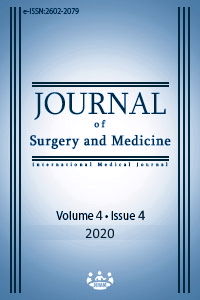A case-control study of two polymorphisms of HIF1A in children with cleft lip/palate and in their mother
Keywords:
Hypoxia-inducible factor 1, Cleft lip, Cleft palateAbstract
Aim: Palatogenesis is a metabolic event that occurs in the initial stages of fetal life. Reports indicate that hypoxia is a critical condition in the formation and elevation of the palate and fusion of the lips. It is known that both environmental and genetic factors play important roles in hypoxia. The ability of the cells to respond to changes in the oxygen pressure that lead to hypoxia depends on the activation of a transcription factor family known as hypoxia-inducible factors (HIFs). This study was conducted to determine the distribution of two polymorphisms of hypoxia-inducible factor 1, alpha subunit (HIF1A) in children with cleft lip/palate and their mothers.
Methods: Two polymorphic structures of HIF1A (Pro582Ser and Ala588Thr) were studied in children with cleft lip/palate and their mothers along with control group children and mothers using the polymerase chain reaction-restriction fragment length polymorphism (PCR-RFLP) method. DNA fragments were monitored by agarose gel electrophoresis after cleavage.
Results: In Ala588Thr comparison, no difference was observed between mothers, children, and their controls. Regarding Pro582Ser, there were differences in the comparison of maternal and children genotypes with control groups (P=0.034 and P=0.023, respectively). In allelic comparisons, there was a difference between mothers of children with cleft lip/palates and the control group (P=0.001). Although this was different in children, it was not as high as in mothers (P=0.026).
Conclusion: HIF1A polymorphisms that change the proline residues may affect the activity or lifespan of HIF1A protein and play a role in the formation of cleft lip/palate.
Downloads
References
Rajion ZA, Alwi Z. Genetics of cleft lip and palate: a review. Malays J Med Sci. 2007;14(1):4-9.
Bekecioğlu M, Türkmen A. Konjenital Yarık Damak ve Dudak Anomalileri [Congenital Cleft Lip-Cleft Palate Anomalies. Turkiye Klinikleri J E N T-Special Topics. 2011;4(3):43-7.
Murray JC. Gene/environment causes of cleft lip and/or palate. Clin Genet. 2002;61(4):248-56. doi:10.1034/j.1399-0004.2002.610402.x.
Lidral AC, Murray JC, Buetow KH, Basart AM, Schearer H, Shiang R, et al. Studies of the candidates genes TGFB2, MSX1, TGFA, and TGFB3 in the etiology of cleft lip and palate in the Phillipines. Cleft Palate Craniofac J. 1997;34(a):1-6. doi: 10.1597/1545-1569_1997_034_0001_sotcgt_2.3.co_2.
Passos-Bueno MR, Gaspar DA, Kamiya T, Tescarollo G, Rabanea D, Richieri-Costa A, et al. Transforming growth factor-alpha and non-syndromic cleft lip with or without palate in Brazilian patients: results of large case-control study. Cleft Palate Craniofac J. 2004;41(4):387–91. doi: 10.1597/03-054.1
Tanabe A, Taketani S, Endo-Ichikawa Y, Tokunaga R, Ogawa Y, Hiramoto M. Analysis of the candidate genes responsible for non-syndromic cleft lip and palate in Japanese people. Clin Sci (Lond). 2000;99(2):105-11. doi: 10.1042/cs0990105.
Moxham BJ. The development of the palate-a brief review. Eur J Anat. 2003;7 Suppl. (1):53-74.
Ferguson MW. Palate development. Development. 1988;103: Suppl:41-60.
Singh GD, Moxham BJ, Langley MS, Embery G. Glycosaminoglycan biosynthesis during 5-fluoro-2-deoxyuridine-induced palatal clefts in the rat. Arch Oral Biol. 1997;42(5):355–63. doi: 10.1016/S0003-9969(97)00031-9.
Gao F, Okunieff P, Han Z, Ding I, Wang L, Liu W, et al. Hypoxia-induced alterations in hyaluronan and hyaluronidase. Adv Exp Med Biol. 2005;566:249-56. doi: 10.1007/0-387-26206-7_33.
Papakonstantinou E, Roth M, Tamm M, Eickelberg O, Perruchould AP, Karakiulakis G. Hypoxia differentially enhances the effects of transforming growth factor-beta isoforms on the synthesis and secretion of glycosaminoglycans by human lung fibroblasts. J Pharmacol Exp Ther. 2002;301(3):830-7. doi: 10.1124/jpet.301.3.830.
Park JY, Park JW, Suh SI, Baek WK. D-glucosamine down-regulates HIF-1alpha through inhibition of protein translation in DU145 prostate cancer cells. Biochem Biophys Res Commun. 2009;382(1):96-101. doi: 10.1016/j.bbrc.2009.02.129.
Tanimoto K, Yoshiga K, Eguchi H, Kaneyasu M, Ukon K, Kumazaki T, et al. Hypoxia-inducible factor-1αpolymorphisms associated with enhanced transactivation capacity, imlpying clinical significance. Carcinogenesis. 2003;24(11):1779-83. doi: 10.1093/carcin/bgg132.
Kim W, Kaelin WG Jr. The von Hippel-Lindau tumor suppressor protein: new insights into oxygen sensing and cancer. Curr Opin Genet Dev. 2003;13(1):55–60. doi: 10.1016/S0959-437X(02)00010-2.
Fransén K, Fenech M, Fredrikson M, Dabrosin C, Söderkvist P. Association between ulcerative growth and hypoxia inducible factor-1α polymorphisms in colorectal cancer patients. Mol Carcinog. 2006;45(11):833-40. doi: 10.1002/mc.20209.
Kosowski TR, Weathers WM, Wolfswinkel EM, Ridgway EB. Cleft Palate. Semin Plast Surg. 2012;26(4):164-9. doi: 10.1055/s-0033-1333883.
Çıldır SK, Çalışkan S, Sandallı N. Dudak-Damak Yarıklarında Etiyoloji, Embriyoloji, Klinik Bulgular ve Tedavi [Etiology, Embryology, Clinical Findings and Treatment of Cleft Lip and Palate]. Ondokuz Mayıs Üniversitesi Diş Hekimliği Fakültesi Dergisi. 2010;11(3):103-8.
Kelly D, O’Dowd T, Reulbach U. Use of folic acid supplements and risk of cleft lip and palate in infants: a population-based cohort study. Br J Gen Pract. 2012;62(600):e466-e472. doi: 10.3399/bjgp12X652328.
Hiraoka M, Kagawa Y. Genetic polymorphisms and folate status. Congenit Anom (Kyoto). 2017;57(5):142-9. doi: 10.1111/cga.12232.
Alfarra HY, Alfarra SR, Sadiq MF. Neural tube defects between folate metabolism and genetics. Indian J Hum Genet. 2011;17(3):126-31. doi: 10.4103/0971-6866.92082
Kumar H, Choi DK. Hypoxia Inducible Factor Pathway and Physiological Adaptation: A Cell Survival Pathway? Mediators Inflamm. 2015;2015:584758. doi: 10.1155/2015/584758.
Smaldone MC, Maranchie JK. Clinical implications of hypoxia inducible factor in renal cell carcinoma. Urol Onc. 2009;27(3):238-45. doi: 10.1016/j.urolonc.2007.12.001.
Millicovsky G, Johnston MC. Hyperoxia and hypoxia in pregnancy: simple experimental manipulation alters the incidence of cleft lip and palate in CL/Fr mice. Proc Natl Acad Sci USA. 1981;78(9):5722-3.
Downloads
- 546 976
Published
Issue
Section
How to Cite
License
Copyright (c) 2020 İbrahim Yıldırım, Nadir Koçak, Kağan Kamaşak
This work is licensed under a Creative Commons Attribution-NonCommercial-NoDerivatives 4.0 International License.
















